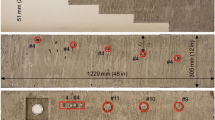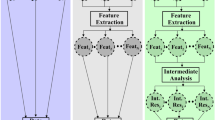Abstract
Non-destructive testing (NDT) of concrete structures plays an increasing role in civil engineering. At present there are several acoustic and electromagnetic methods, which cover a large area of application and which can be used complementarily. But in most cases, only one method is applied to solve a distinct problem. In this contribution, results will be presented based on the networked research project FOR384, funded by the Deutsche Forschungsgemeinschaft (DFG). Among others, the combiantion of NDT methods, and thus the application of data fusion techniques, has been investigated to demonstrate synergetic effects by merging complementary results and amplifying information about concrete structures. In order to be able to combine NDT-data from several methods recorded from the same volume, the different data sets must, be adapted. After the data sets are reconstructed and transferred into a common reference system, they can be processed in different ways according to the purpose of the investigation. The results, which have been achieved in concrete tets specimens and on the carriageway of a bridge with radar, ultrasonic echo and impact echo, will be presented and will show the feasibility of the data fusion method.
Résumé
Les contrôles non destructifs (CND) sur des constructions en béton jouent un rôle de plus en plus grand en génie civil. Il existe à présent plusieurs méthodes, acoustiques et électromagnétiques dont le domaine d'application es, large et qui peuvent être complémentaires les unes des autres. Mais dans la plupart des cas, seule une méthode est appliquée pour résoudre un problème spécifique. Dans cet article seront présentés les résults, basés sur un projet de recherche en réseau, FOR384, financé par la Deutsche, Forschungsgemeinschaft (DFG). On a notamment étudié la combinaison de méthodes de contrôles non destructifs, et donc l'application de techniques de fusion de données, dans le but de démontrer les effets synergétiques en fusionnant les résultats complémentaires et en amplifiant l'information sur les constructions en béton. Afin, de pouvoir combiner les données des CND provenant de plusieurs méthodes, enregistrées à partir du même volume, différentes séries de données doivent être adaptées. Après avoir été reconstruites et transférées dans un système commun de références, les séries de données peuvent être traitées de différentes façons selon l'objectif de la recherche. Les résultats obtenus à partir d'échantillons, de béton et sur la chaussée d'un pont au moyen des techniques de radar, d'écho ultrasonique et d'écho d'impact seront présentés afin de démontrer la faisabilité de la méthode de fusion des données.
Similar content being viewed by others
References
haardt, P., ‘NDT Methods for the inspection of highway structures’, in ‘International Symposium Non-Destructive Testing in Civil Engineering (NDT-CE)’, Berlin, Germany, September 2003, DGZfP, Berlin, 2003), Proceedings on BB 85-CD, V01
Bungey, J.H., Millard, S.G. and Shaw, M.R., ‘Radar assessment of post-tensioned concrete’, in ‘7th Int. Conf. on Structural Faults and Repair’, Edinburgh, UK, 1997, (Ed. M.C. Forde, Engineering Technics Press, Edinburgh, 1997) Vol. 1, 331–339.
Krause, M., Bärmann, R., Friedlinghaus, R., Kretzschamar, F., Kroggel, O., Langenberg, K., Maierhofer, Ch., Müller, W., Neisecke, J., Schickert, M., Schmitz, V., Wiggenhauser, H. and Wollbold, F., ‘Comparison of pulse-echo methods for testing concrete’,NDT&E International 4 (special issue) (1997) 195–204.
Krause, M., Maierhofer, C. and Wiggenhauser, H., ‘Thickness measurement of concrete elements using radar and ultrasonic impulse echo techniques’, in ‘6th International Conference on Structural Faults and Repair’, London, UK, July 1995 (M.C. Forde, Engineering Technics Press, Edinburgh 1995) Vol. 1, 17–24.
Haardt, P., Krause, M. Streicher, D. and Krause, H.-J., ‘Canning NDT-methods for the inspection of highway structures’, in ‘2nd International Conference on Bridge Maintenance, Safety and Management’, Kyoto, Japan, October 2004 [in press].
Maierhofer, Ch., Krause, M. and Wiggenhauser, H., ‘Non-destructive investigation of sluices using radar and ultrasonic impulse echo’,NDT&E International 31 (6) (1998) 421–427.
Funk, Th., Maierhofer, Ch., Leipold, S. and Borchardt, K., ‘Non-destructive location of tendon ducts in concrete for the installation of noise insulating walls using impulse radar’, in ‘7th Int. Conf. on Structural Faults and Repair’, Edinburgh, UK, 1997, (M.C. Forde, Engineering Technics Press, Edinburgh, 1997) Vol. 2, 323–329.
Colla, C. and Maierhofer, Ch., ‘Investigation of historic masonry via radar reflection and tomography’, in ‘8th International Conference on GPR 2000’, Gold Coast, Australia, May 2000, (Noon, D., Brisbane, 2000, SPIE Vol. 4084) 893–898.
Maierhofer, Ch., Leipold, S., Schraurich, D., Binda, L. and Saisi, A., ‘Determination of the moisture distribution in the outside walls of S. Maria Rossa using radar’, in ‘7th Int. Conference on Ground Penetration Radar (GPR)’, Lawrence, USA, May 1998, (Radar Systems and Remote Sensing Laboratory, Lawrence, 1998) Vol. 2, 509–514.
Afshari, A., Frazer, D. and Creese, R., ‘Ultrasonic techniques for the bonding of rebar in concrete structures’, in ‘Structural Materials Technology—An NDT Conference’, San Diego, USA, February 1996 (Hartbower, P. and P. Stolarski, Technomic Publishing Co., Lancaster, Basel, 1996) 3–8.
Hevin, G., Abraham, O., Pedersen, H.A. and Campillo, M., ‘Characterisation of surface cracks, with Rayleigh waves: a numerical model’ Non-Destructive Testing and Evaluation International 31 (1998) 289–297.
Kuo, M., Lin, T., Liu, P. and Wu, T., ‘Locating the crack tip of a surface-breaking crack. Part I-Line crack’,Ultrasonics 36(7) (1998) 803–811.
Wiggenhauser, H., ‘Duct inspection using scanning impactecho’, in ‘International Symposium Non-Destructive Testing in Civil Engineering (NDT-CE)’, Berlin, Germany, September 2003, (DGZfP, Berlin, 2003), Proceedings on BB 85-CD, V101.
Williams, T., Sansalone, M. and Grigoriu, M., ‘Establishing the basis for using Transient stress waves for Nondestructive evaluation of Masonry’,Journal of the (US) Masonry Society 16(1) (1998) 55–68.
Dupuis, O., Kaftandjian, V., Drake, S., Hansen, A. and Casagrande, J.M., ‘A combined system for ultrasonic and X-ray inspection of welds’, in ‘15th World Conference on Non-Destructive Testing’, Rome, Italy, October 2000 (AIPND, Brescia, 2000) CD.
François, N., ‘A New Advanced Multitechnique Data Fusion Aloorithm for NDT’, in ‘15th World Conference on Non-Destructive Testing’, Rome, Italy, October 2000, (AIPND, Brescia, 2000), CD.
Gros, X.-E., ‘Application of NDT Data Fusion’ (Kluwer Academic Publishers, Boston, Dordrecht, London, 2001).
Forsyth, D.S., Liu, Z., Komorowski J.P. and Peeler, D., ‘An application of NDI data fusion to aging aircraft structures’, in ‘6th Conference on Aging Aircraft’, San Francisco, USA, September 2002 (San Francisco, 2002).
Pöpel, M. and Flohrer, C., ‘Combination of a Covermeter with a radar system—An improvement of radar application in civil engineering’, in ‘International Symposium Non-Destructive Testing in Civil Engineering (NDT-CE)’, Berlin, Germany, September 1995 (DGZfP, Berlin, 1995) Vol. 1, 737–743.
Derobert, X., Abraham, O. and Ch. Aubagnac, ‘Review of NDT methods on weak post-tensioned beam before autopsy’, in ‘GRP 2002 9th International Conference on Ground Penetrating Radar’, Santa Barbara, USA, May 2002 (University of California, Santa Barbara, 2002) 365–370.
Annan, A.P., Cosway, S.W. and De Souza, T., ‘Application of GPR to map concrete to delineate embedded structural elements and defects’, in ‘GPR 2002, 9th International Conference on Ground Penetrating Radar’, Santa Barbara, USA, May 2002 (University of California, Santa Barbara, 2002) 359–364.
Schickert, M., ‘Towards SAFT-imaging in ultrasonic inspection of concrete’, in ‘International Symposium Non-Destructive Testing in Civil Engineering (NDT-CE)’ Berlin, Germany, September 1995 (DGZfP, Berlin, 1995) Vol. 1, 411–418.
Schmitz, V., Chakhlov, S. and Müller, W., ‘Synthetic aperture focusing technique—State of the art’, in ‘First International Conference on NDE in Relation to Structural Integrity for Nuclear and Pressurised Components’ Amsterdam, Netherlands, Oct. 1998 (Eds. M. Bièth, J.-L. Monjaret, Woodhead Publishing, 1999) 488–494.
Mayer, K., Marklein, R., Langenberg, K.J. and Kreuter, T., ‘Three-dimensional imaging system based on Fourier transformation synthetic aperture focusing technique’Ultrasonics 28 (1990) 241–255.
Schickert, M., Krause, M. and Müller, W., ‘Ultrasonic imaging of concrete elements using reconstruction by synthetic aperture focusing technique’,Journal of Materials in Civil Engineering (JMCE) 15 (3) (2003) 235–246.
Stolt, R.H., ‘Migration by Fourier transform’,Geophysics 43 (1) (1978) 23–48.
Mielentz, F., Milman, B., Krause, M. and Wiggenhauser, H., ‘Implementation of the ultrasonic impulse echo techniques for the inspection of concrete structures’, in Symposium of Structure Investigation—Practical Application of Non-Destructive Testing Methods, 21–22 January 1999, Munich, DGZfP Vol. 66-CD (1999) poster 3 [in German].
Krause, M., Streicher, D., Wiggenhauser, H., Haardt, P. and Holst, R., ‘Non-destructive testing of a post tensioned concrete bridge applying an, automated measuring system’, in ‘Structural Materials Technology (SMT), NDE/NDT for Highways and Bridges 2004’, Buffalo, NY, USA, Sept. 2004, (Buffalo, 2004).
Author information
Authors and Affiliations
Additional information
Editorial note BAM (Germany) is a RILEM Titular Member. Dr. Martin Krause and Dr. Christiane Maierhofer participate in RILEM TC INR ‘Interpretation of NDT results and assessment of RC structures’.
Rights and permissions
About this article
Cite this article
Kohl, C., Krause, M., Maierhofer, C. et al. 2D- and 3D-visualisation of NDT-data using data fusion technique. Mat. Struct. 38, 817–826 (2005). https://doi.org/10.1007/BF02481654
Received:
Accepted:
Issue Date:
DOI: https://doi.org/10.1007/BF02481654




